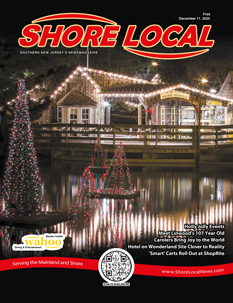By Bruce Klauber
From the 1940s through the 1960s, Atlantic City was a moviegoer’s paradise. Given that there is currently only one movie theater operating within the city limits today – IMAX at the Tropicana – it’s hard to believe that at one time Atlantic City was home to more than a dozen motion picture theaters, and some were spectacular movie palaces.
Here are some of the more impressive ones:
The Warner Theatre, renamed the Warren Theatre sometime in the 1950s, has been very much in the news of late via last year’s restoration by Ross Mollison’s Spiegelworld. It’s now home to the spectacular show, “The Hook.”
As a movie theater, the Warner Theatre opened in 1929, boasting Spanish/Moorish design with a Venetian styled lobby and seating for an incredible 4,189 people. Through the years, the Warner hosted the Miss America Pageant, and by the 1950s, presented live shows, including top-tier legitimate theater. Steel Pier magnate George Hamid, Jr. owned the venue beginning in the late 1950s. But by the early 1960s he realized that the theater was too large to make any money. A good portion of it was torn down circa 1962, and Hamid opened it as a bowling alley a year later. What was left of it was home to various businesses, including a pizza parlor, until Spiegelworld came along to spearhead restoration last year.
The Roxy, at the Boardwalk and Kentucky Avenue, seated 1,963 and was said to be one of the largest movie theaters in the city. It opened in 1925 as the Stanley Theatre, and the name was changed to the Roxy Theatre in 1957, when George Hamid bought it. Hamid was quite the movie house mogul in those days, as he owned, at one time or another, the Shore, the Warren, the Hollywood, the Virginia, and the Center Theatre. It limped along until 1974, still showing first-run pictures, when it was briefly turned into an indoor kiddie amusement park. A fire destroyed it in the early 1980s.

The Embassy, at New York and Atlantic avenues, opened in 1941 and also survived into the 1970s. It seated 1,485 and was one of three theaters in the city that was a part of The Embassy company. It was sold in 1970, closed five years later, and then reopened again until its permanent closure in 1978.
Another movie house with the Embassy Theatre name opened in 1911 at 1831 Atlantic Ave., and seated 965. It became the Shore Theatre in 1941, then the Beach Theatre in 1952. The Beach, which became an adult movie house in its later years, hung on until 1990 when a fire destroyed a good portion of it.
The 800-seat Towne Cinema was built close to Atlantic City’s Inlet section at 619 Atlantic Ave. When it opened circa 1914, it was called the Liberty Theatre, then became the Astor Theatre in 1931. Sam Shapiro, later known as the head of the Greater Delaware Valley’s Sam-Eric theater chain, took over operation of it and kept it going until 1968. Shapiro closed it for a year and then, believing there was still life left in the property, reopened it in 1969 as Towne Cinema. It closed again briefly in 1970, but reopened again for a short time in 1971. The last films to be shown were a grade “B” double bill: “A Stranger in Town” and “The Stranger Returns.” It remained vacant until a fire destroyed it in 1975.
History is a little murky regarding the Center Theatre and the Charles Theatre. Though they both opened on July 2, 1913, and closed in July of 1977, it appears that they were located several blocks away from each other. The Center, at 1517 Atlantic Ave., seated 1,391. The Charles, a 650-seater, had a 2217 Atlantic Ave. address.

Adjoining the Center Theatre was the Hollywood Theatre. Built in 1934 with 1,712 seats, it sported an Arabian Nights decor. The Hollywood, which opened as a vaudeville house, kept going into the 1970s and showed adult films from 1973 to 1975. It reverted to a first-run movie venue in 1975 until it closed two years later.
The Strand seated 1,156 moviegoers and was built just across the Boardwalk from the Steel Pier in 1910. It originally opened as a live theater, but the record books indicate that the Strand switched to showing movies around 1914. It stayed in business, showing first-run movies until 1970, despite competition from the Steel Pier, which showed several, relatively new movies per day for years. In 1970, the Strand became an adult movie house. That concept lasted for two years. It reopened in 1973 and called itself the “Talkies Theatre,” which specialized in showing classic motion pictures. It was a novel concept for the Boardwalk, and it managed to stay in business until 1979.
The Steel Pier area was a hotbed for movie houses for years. The Virginia Theatre, at Virginia Avenue and the Boardwalk, opened in 1916 and seated 1,000 patrons. Around 1941, Warner Brothers Circuit Management Corporation, the division of Warner Brothers pictures that operated movie theaters, took over operations. Warner put a good deal of time and effort into this venue, which eventually became known as Atlantic City’s “movie house jewel,” devoted to showing road-show films. The first-run films often had reserved seat ticketing and intermissions, which were later shown in stereo sound with a 70mm screening capability.
The Virginia kept at it until late 1973. The official report was that the theater closed in that year because the entire block was purchased for future casino development. What makes that 1973 report questionable is that gambling was not legalized in Atlantic City until 1976, and the first casino didn’t open until 1978. Did the “developers” know something that no one else knew in 1973?
Two of the most fondly-remembered movie theaters were not in Atlantic City, but in neighboring Ventnor and Margate. The “original” Ventnor Square Theatre had 968 seats and opened in 1922. In 1936, the venue was remodeled in the Art Deco style, and it continued operating successfully until 1979, when another screen was added. In 1998, Ventnor city inspectors determined that the theater was on the verge of collapsing and the theater was closed.
Many in the Ventnor area believed that it could not be saved. Fortunately, it was purchased at a nominal cost. Reports at the time indicated it was bought by the Frank theater chain. And to everyone’s amazement, it was fully restored within just one year and reopened on June 16, 2001, with an additional screen. It finally closed on Dec. 2, 2004.

In 2018, what was left of the venue was purchased by Clint Bunting, Scott Kaufman, and one-time Ventnor resident Brett DeNafo. It took three years and $5 million, but on May 22, 2021, the restored, state-of-the-art, three-screen Ventnor Square Theatre reopened, complete with the old theater’s original light fixtures, railings, wood, and the glass partitions of the staircase.
The Margate Theatre, at Devlin and Ventnor avenues, opened in 1938 and had seating for 802. It was tremendously successful, and became “The Margate Twin,” with an additional screen in 1973. The closing of The Margate wasn’t widely reported, but those who frequented the theater remember seeing films there in the mid-1980s.
Though it’s not likely that we’ll see a return to the days where there was a movie palace on every corner, the success of the revamped Ventnor Square Theatre, the great business being done at the Trop’s IMAX, and the healthy business at the IMAX and Tilton 9 in Northfield indicate that there is still a large market for those who want to go to the local movie house to catch a film.
Bruce Klauber is the author of four books, an award-winning music journalist, concert and record producer and publicist, producer of the Warner Brothers and Hudson Music “Jazz Legends” film series, and performs both as a drummer and vocalist.












